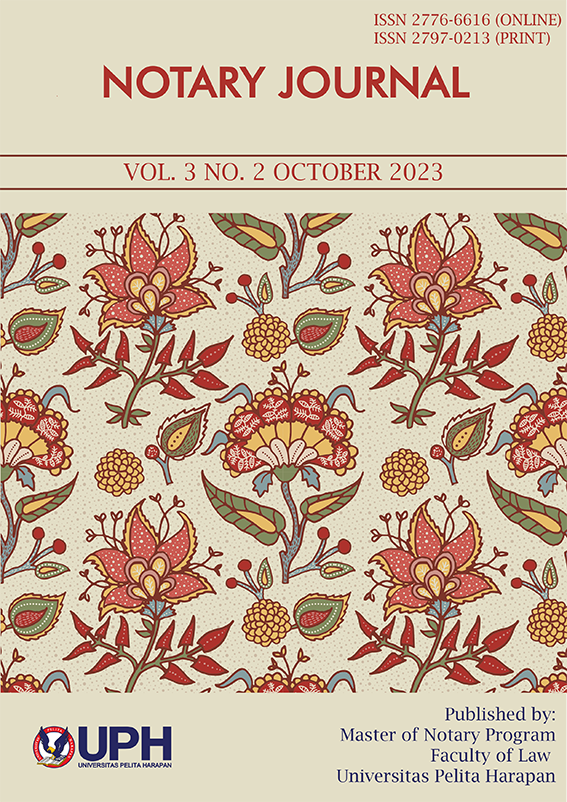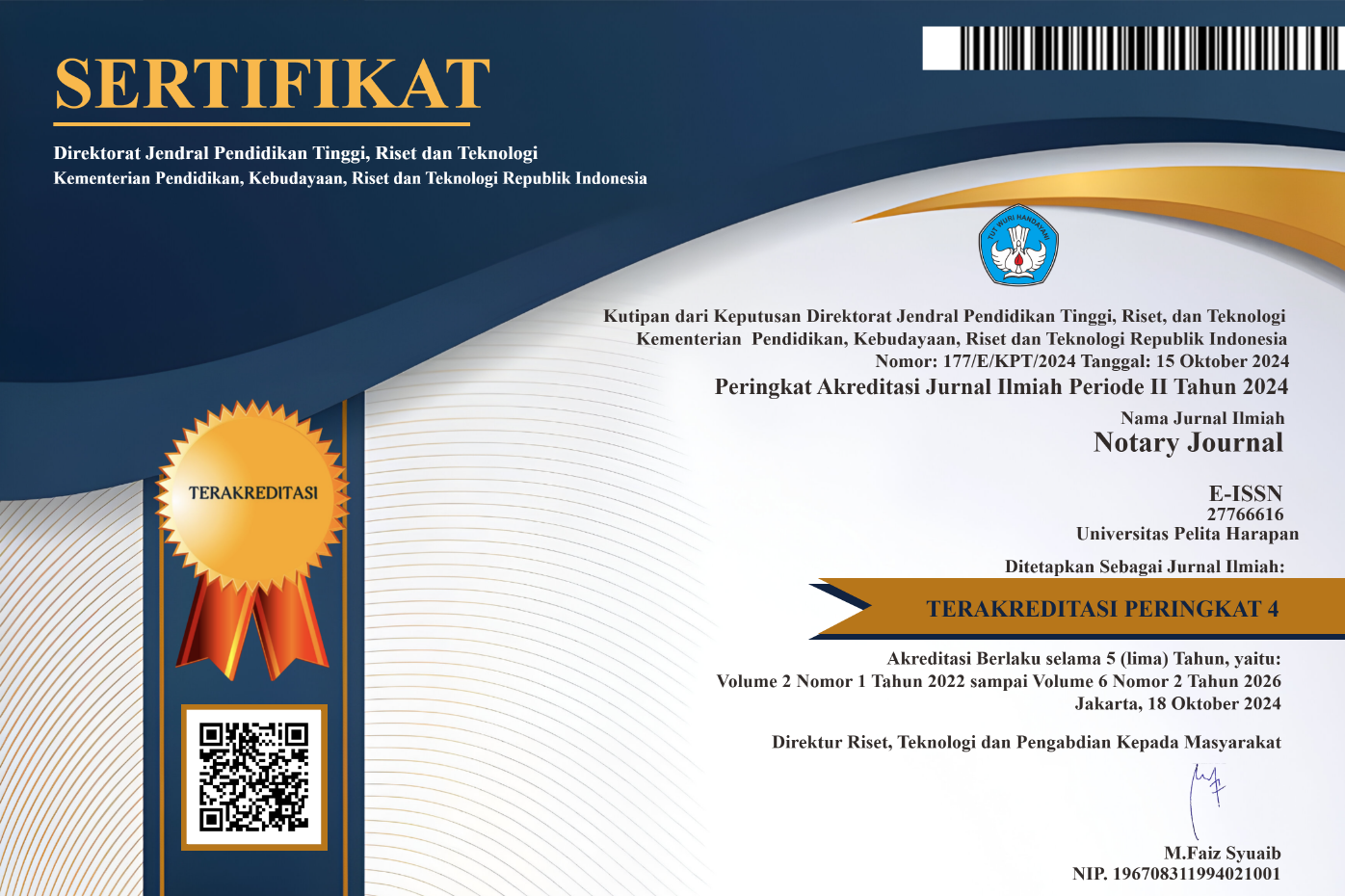Tanggung Jawab Notaris Terhadap Akta Autentik yang Dibuat Tanpa Dihadiri Pihak Penghadap
DOI:
https://doi.org/10.19166/nj.v3i2.7083Kata Kunci:
Authentic Deed, Without Attendance, Notary, Akta Autentik, Tanpa Dihadiri Penghadap, NotarisAbstrak
An authentic deed is a perfect piece of evidence, which means that an authentic deed has physical, formal and material evidentiary power in accordance with the provisions based on Article 1886 of the Civil Code. Notaries play an important role in the process of making an authentic deed, the provisions of which are regulated in general law as well as the code of ethics attached to Notaries. However, sometimes when making an authentic deed, various problems are often found in the preparation process, one of which is the carrying out of the authentic deed without the presence of the party present. This research intends to examine the responsibilities and legal consequences of this problem. This research is normative juridical research using secondary data through statue approach case approach. It was found that the Notary violated the Law of Notary Position, has a number of responsibilities, and authentic deeds made under such conditions also have legal consequences that are detrimental to the parties to the deed.
Bahasa Indonesia Abstrak: Akta autentik merupakan suatu alat bukti yang sempurna yang artinya akta autentik memiliki kekuatan pembuktian secara lahiriah, formal dan materiil sesuai ketentuan berdasarkan Pasal 1886 KUH Perdata. Notaris berperan penting dalam proses pembuatan suatu akta autentik yang mana ketentuannya diatur dalam undang-undang secara umum begitu juga dengan kode etik yang melekat terhadap Notaris. Namun terkadang dalam pembuatan akta autentik sering ditemukan berbagai masalah dalam proses penyusunannya, salah satunya adalah dengan dilaksanakannya pembuatan akta autentik tanpa dihadiri pihak penghadap. Penelitian ini bermaksud untuk menelaah mengenai tanggung jawab dan akibat hukum atas masalah tersebut. Penelitian ini adalah penelitian yuridis normatif dengan menggunakan data sekunder melalui pendekatan undang-undang dan pendekatan kasus. Ditemukan bahwa Notaris melanggar UUJN, memiliki sejumlah tanggung jawab, dan terhadap akta autentik yang dibuat dengan kondisi demikian juga memiliki akibat hukum yang merugikan para pihak dalam akta tersebut.
Referensi
Legislative Regulations/Peraturan Perundang-Undangan
Kitab Undang-Undang Hukum Perdata.
Kitab Undang-Undang Hukum Pidana.
Undang-Undang Nomor 30 Tahun 2004 tentang Jabatan Notaris. Lembaran Negara Republik Indonesia Tahun 2004 Nomor 117, Tambahan Lembaran Negara Republik Indonesia Nomor 4432.
Undang-Undang Nomor 2 Tahun 2014 tentang Perubahan atas Undang-Undang Nomor 30 Tahun 2004 tentang Jabatan Notaris. Lembaran Negara Republik Indonesia Tahun 2014 Nomor 3, Tambahan Lembaran Negara Republik Indonesia Nomor 5491.
Undang-Undang Nomor 30 Tahun 1999 tentang Arbitrase dan Alternatif Penyelesaian Sengketa. Lembaran Negara Republik Indonesia Tahun 1999 Nomor 138, Tambahan Lembaran Negara Republik Indonesia Nomor 3872.
Books/Buku
Andasasmita, Komar. Notaris II. Bandung: Sumur, 1983.
Pramudya, Kelik and Ananto Widiatmoko. Pedoman Etika Profesi Aparat. Yogyakarta: Pustaka Yusticia, 2010.
Prodjodikoro, Wirjono. Perbuatan Melanggar Hukum, Cetakan V. Bandung: Sumur, 1967.
Soerodjo, Irawan. Kepastian Hukum Hak atas Tanah di Indonesia. Surabaya: Arkola, 2003.
Sudarsono. Kamus Hukum, Cetakan V. Jakarta: Rineka Cipta, 2007.
Tobing, G.H.S. Lumban. Peraturan Jabatan Notaris. Jakarta: Penerbit Erlangga, 1999.
Scientific Journal/Jurnal Ilmiah
Setiawan, Wawan. “Kekuatan Hukum Akta Notaris Sebagai Alat Bukti.” Varia Peradilan 48 (September 1989).
Decision/Putusan
Putusan Majelis Pengawas Wilayah Notaris Sumatera Selatan Nomor 001/Pts/Mj.PWN Prov.Sumatera Selatan/X/2022.
Unduhan
Diterbitkan
Cara Mengutip
Terbitan
Bagian
Lisensi
Authors who publish with this journal agree to the following terms:
1) Authors retain copyright and grant the journal right of first publication with the work simultaneously licensed under a Creative Commons Attribution License (CC-BY-SA 4.0) that allows others to share the work with an acknowledgement of the work's authorship and initial publication in this journal.
2) Authors are able to enter into separate, additional contractual arrangements for the non-exclusive distribution of the journal's published version of the work (e.g., post it to an institutional repository or publish it in a book), with an acknowledgement of its initial publication in this journal.
3) Authors are permitted and encouraged to post their work online (e.g., in institutional repositories or on their website). The final published PDF should be used and bibliographic details that credit the publication in this journal should be included.



